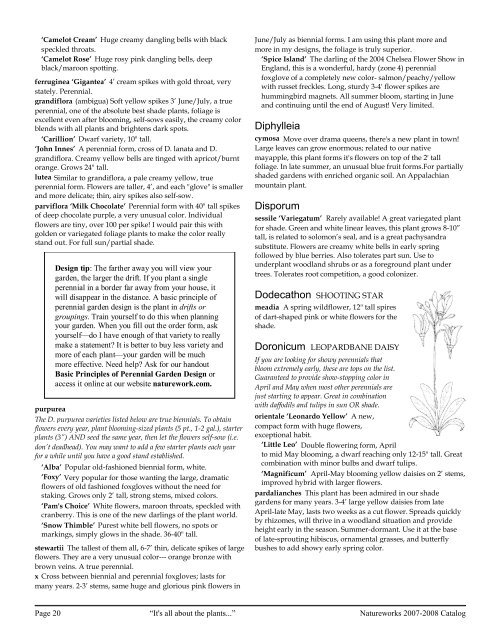2007-2008 Natureworks Catalog
2007-2008 Natureworks Catalog
2007-2008 Natureworks Catalog
You also want an ePaper? Increase the reach of your titles
YUMPU automatically turns print PDFs into web optimized ePapers that Google loves.
‘Camelot Cream’ Huge creamy dangling bells with black<br />
speckled throats.<br />
‘Camelot Rose’ Huge rosy pink dangling bells, deep<br />
black/maroon spotting.<br />
ferruginea ‘Gigantea’ 4’ cream spikes with gold throat, very<br />
stately. Perennial.<br />
grandiflora (ambigua) Soft yellow spikes 3’ June/July, a true<br />
perennial, one of the absolute best shade plants, foliage is<br />
excellent even after blooming, self-sows easily, the creamy color<br />
blends with all plants and brightens dark spots.<br />
‘Carillion’ Dwarf variety, 10" tall.<br />
‘John Innes’ A perennial form, cross of D. lanata and D.<br />
grandiflora. Creamy yellow bells are tinged with apricot/burnt<br />
orange. Grows 24" tall.<br />
lutea Similar to grandiflora, a pale creamy yellow, true<br />
perennial form. Flowers are taller, 4’, and each "glove" is smaller<br />
and more delicate; thin, airy spikes also self-sow.<br />
parviflora ‘Milk Chocolate’ Perennial form with 40" tall spikes<br />
of deep chocolate purple, a very unusual color. Individual<br />
flowers are tiny, over 100 per spike! I would pair this with<br />
golden or variegated foliage plants to make the color really<br />
stand out. For full sun/partial shade.<br />
Design tip: The farther away you will view your<br />
garden, the larger the drift. If you plant a single<br />
perennial in a border far away from your house, it<br />
will disappear in the distance. A basic principle of<br />
perennial garden design is the plant in drifts or<br />
groupings. Train yourself to do this when planning<br />
your garden. When you fill out the order form, ask<br />
yourself—do I have enough of that variety to really<br />
make a statement? It is better to buy less variety and<br />
more of each plant—your garden will be much<br />
more effective. Need help? Ask for our handout<br />
Basic Principles of Perennial Garden Design or<br />
access it online at our website naturework.com.<br />
purpurea<br />
The D. purpurea varieties listed below are true biennials. To obtain<br />
flowers every year, plant blooming-sized plants (5 pt., 1-2 gal.), starter<br />
plants (3”) AND seed the same year, then let the flowers self-sow (i.e.<br />
don’t deadhead). You may want to add a few starter plants each year<br />
for a while until you have a good stand established.<br />
‘Alba’ Popular old-fashioned biennial form, white.<br />
‘Foxy’ Very popular for those wanting the large, dramatic<br />
flowers of old fashioned foxgloves without the need for<br />
staking. Grows only 2’ tall, strong stems, mixed colors.<br />
‘Pam's Choice’ White flowers, maroon throats, speckled with<br />
cranberry. This is one of the new darlings of the plant world.<br />
‘Snow Thimble’ Purest white bell flowers, no spots or<br />
markings, simply glows in the shade. 36-40" tall.<br />
stewartii The tallest of them all, 6-7’ thin, delicate spikes of large<br />
flowers. They are a very unusual color--- orange bronze with<br />
brown veins. A true perennial.<br />
x Cross between biennial and perennial foxgloves; lasts for<br />
many years. 2-3’ stems, same huge and glorious pink flowers in<br />
June/July as biennial forms. I am using this plant more and<br />
more in my designs, the foliage is truly superior.<br />
‘Spice Island’ The darling of the 2004 Chelsea Flower Show in<br />
England, this is a wonderful, hardy (zone 4) perennial<br />
foxglove of a completely new color- salmon/peachy/yellow<br />
with russet freckles. Long, sturdy 3-4' flower spikes are<br />
hummingbird magnets. All summer bloom, starting in June<br />
and continuing until the end of August! Very limited.<br />
Diphylleia<br />
cymosa Move over drama queens, there's a new plant in town!<br />
Large leaves can grow enormous; related to our native<br />
mayapple, this plant forms it's flowers on top of the 2' tall<br />
foliage. In late summer, an unusual blue fruit forms.For partially<br />
shaded gardens with enriched organic soil. An Appalachian<br />
mountain plant.<br />
Disporum<br />
sessile ‘Variegatum’ Rarely available! A great variegated plant<br />
for shade. Green and white linear leaves, this plant grows 8-10”<br />
tall, is related to solomon’s seal, and is a great pachysandra<br />
substitute. Flowers are creamy white bells in early spring<br />
followed by blue berries. Also tolerates part sun. Use to<br />
underplant woodland shrubs or as a foreground plant under<br />
trees. Tolerates root competition, a good colonizer.<br />
Dodecathon SHOOTING STAR<br />
meadia A spring wildflower, 12" tall spires<br />
of dart-shaped pink or white flowers for the<br />
shade.<br />
Doronicum LEOPARDBANE DAISY<br />
If you are looking for showy perennials that<br />
bloom extremely early, these are tops on the list.<br />
Guaranteed to provide show-stopping color in<br />
April and May when most other perennials are<br />
just starting to appear. Great in combination<br />
with daffodils and tulips in sun OR shade.<br />
orientale ‘Leonardo Yellow’ A new,<br />
compact form with huge flowers,<br />
exceptional habit.<br />
‘Little Leo’ Double flowering form, April<br />
to mid May blooming, a dwarf reaching only 12-15" tall. Great<br />
combination with minor bulbs and dwarf tulips.<br />
‘Magnificum’ April-May blooming yellow daisies on 2’ stems,<br />
improved hybrid with larger flowers.<br />
pardalianches This plant has been admired in our shade<br />
gardens for many years. 3-4’ large yellow daisies from late<br />
April-late May, lasts two weeks as a cut flower. Spreads quickly<br />
by rhizomes, will thrive in a woodland situation and provide<br />
height early in the season. Summer-dormant. Use it at the base<br />
of late-sprouting hibiscus, ornamental grasses, and butterfly<br />
bushes to add showy early spring color.<br />
Page 20 “It's all about the plants...”<br />
<strong>Natureworks</strong> <strong>2007</strong>-<strong>2008</strong> <strong>Catalog</strong>


